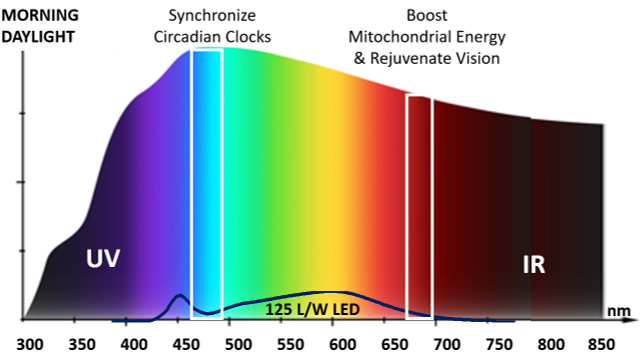There is something special about sunlight in the mornings. Now new research is telling us that the time of day you spend outside in daylight is critical.
Regular outdoor exposure to natural unfiltered full-spectrum daylight provides clear health benefits even on cloudy overcast days. Large scale studies with thousands of people show that lifespan is increased by years, depression and anxiety are substantially reduced and cardiovascular disease is minimized, as compared to people who spend most of their time indoors1.
But does the time of day that you are exposed to daylight matter?

Resetting Circadian Clocks
We have long known that blue-rich morning daylight corrects the drift of circadian clocks to later hours caused by evening blue-rich LED light exposure. A morning dose of bright blue rich daylight in the 460-490 nm segment of the light spectrum is a highly potent synchronizer of circadian clocks. Exposure to daylight later in the day, however, does not have the same effect.
Boosting Vision in the Ageing Eye
Now, there is another reason to favor morning daylight outdoors. Deep red light at about 670 nm boosts vision, reversing the effects of ageing on the human eye. But this red light treatment is only effective in the morning and doesn’t work later in the day2.
Red light and invisible near-infrared in the range 650 – 1000 nm penetrate beneath the skin and boost mitochondrial energy production. Mitochondria are the tiny batteries inside the cells of the body that synthesize the ATP (adenosine triphosphate) chemical energy that powers metabolism. As we age ATP energy production drops off, especially in the retina of the eye which has the highest usage of energy and concentration of mitochondria3.
Exposing the photoreceptors in the eye to red light revs up the mitichondria energy production and corrects the degradation of vision that begins at about age 40.
This is part of the much broader health-boosting effects of red and infrared which will discuss in another Substack post.
Reducing Body Fat and Appetite
Bright blue-rich morning light is also effective in reducing body fat and appetite in obese women4. Conversely blue rich light in the evening boosts appetite and promotes weight gain. This is yet one more example of why the timing of light exposure matters.
Failure of Our Modern LED lights
When lighting is regulated to promote cheap white brightness, measured by Lumens/Watt (the intensity of green and yellow wavelengths produced per watt of electricity) , you get a very distorted artificial light.
As the chart above shows, LEDs that are designed to meet the Department of Energy (DOE) new 125 lumens per watt standard, which goes into effect in 2028, are deficient in 460 – 490 nm blue and also in 670 nm red and infrared. In other words staying indoors under such deficient LED lighting cannot in any way replace the benefits of natural outdoor daylight.
Campaign for Healthy Lighting
I urge you to join the campaign to protect healthy lighting and indicate that you are willing to sign a petition to reverse the harmful DOE 125 lumens per watt rule which is scheduled to go into effect in 2028.
